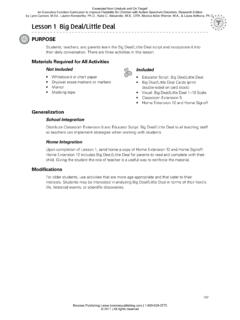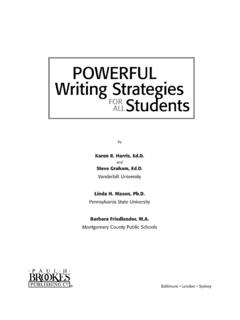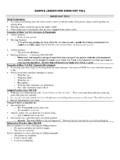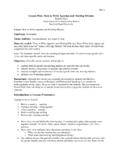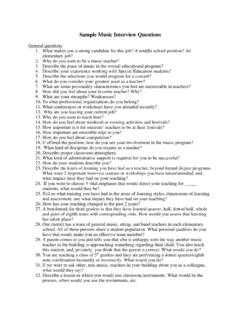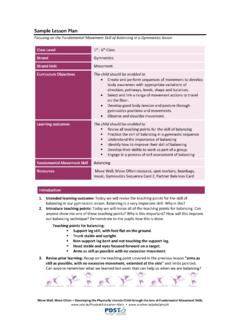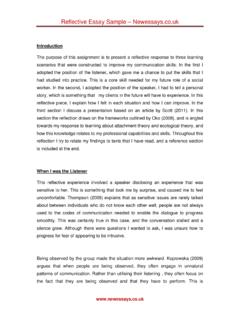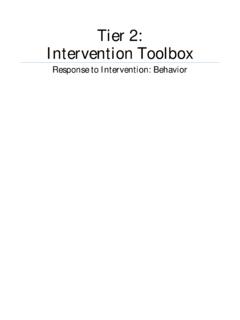Transcription of Understanding Other People’s Emotions
1 75 Understanding OtherPeople s EmotionsPurpose To teach students how to identify others Emotions andto take different perspectivesObjectives Students will learn to use physical cues to understandhow someone else is feeling. Students will learn how to take the perspective ofothers. Students will generalize or apply this lesson to NEEDED Supplement (overhead transparency) Supplement (overhead transparency) Supplement (in-class handout) Supplement (homework handout)Lesson5 TEACHER NOTES_____Excerpted from Strong Kids Grades 6 8: A Social and Emotional Learning Curriculumby Kenneth W. Merrell, with assstance from Dianna Carrizales, , Laura Feuerborn, , Barbara A. Gueldner, , and Oanh K. Tran, Publishing | | 1-800-638-3775 2007| All rights reservedReviewTo activate prior knowledge, review and discuss previous topics and main 3 5 adequate ideas.
2 Discuss with students their responses to last week shomework ScriptDuring our last meeting, we talked about inappropriate and appropriate waysto deal with your anger. Raise your hand if you can tell me an important ideawe learned from this Discussed in lesson 4 How do you define emotion, anger, aggression, frustration,and angermanagement? All people have Emotions . Anger is a necessary and natural reaction. Aggression is not the best way to deal with anger. There are Other ways to react to anger. What are the long-term problems to being angry and aggressive? What are the steps of the Anger Model? What are anger control skills?IntroductionCommunicate the lesson s purpose and objectives clearly. Introduce the concept ofempathy, to understand and better identify Other people s ScriptToday, we will learn about a skill called empathy.
3 We will learn how to noticeother people s feelings, try to understand those feelings better, and see asituation from another person s and Define SkillsActivity AUse Supplement as an overhead transparency to discuss the following students to read each definition. Facilitate brief discussions on each ScriptHere are some important ideas that we will be Strong Kids Grade 6 8 Curriculum2 3 minutes2 minutes5 8 minutesExcerpted from Strong Kids Grades 6 8: A Social and Emotional Learning Curriculumby Kenneth W. Merrell, with assstance from Dianna Carrizales, , Laura Feuerborn, , Barbara A. Gueldner, , and Oanh K. Tran, Publishing | | 1-800-638-3775 2007| All rights reserved Emotion A feeling that comes from something happening to you that ismeant to tell you something.
4 An emotion is usually identified by feelings inyour body or thoughts in your mind. Empathy Understanding another person s feelings or Emotions . Perspective/point of view Feelings and opinions each person has in anexperience. Clues/cues Signals or signs you can see that tell you something aboutanother BConvey the following main ideas to your students using your own words or thesample script. Emphasize to students that looking for clues will help them in em-pathizing with others feelings. The first part of empathy is finding out how someone feels. We can ask a person how he or she feels. It might be possible to tell someone s emotional state by looking for visual cues. People may or may not share the same perspective in the same situation. If we know how someone is feeling, we can better understand him or her andbe ScriptThe first part of empathy is finding out how someone else is feeling.
5 We canask a person how he or she feels, but first we can try to figure out how theperson feels by looking for clues. If we can find clues, we might be able toguess how the person is feeling. Then, we can try to see things from the otherperson s perspective. Different people might feel different things and feelings,even in the same situation. If we can find the Other person s perspective, wemight be able to understand and get along with him or her EmotionsThis activity is designed to give students experience in showing how a particularevent can bring about an emotion, which, in turn, can be discerned by visual the list of Emotions on Supplement as an overhead transparency. With-out telling the students the emotion you choose, model embarrassed body lan-guage by putting your head down, your hand up to your face, and your arms closeto your body.
6 Ask students to guess the emotion that you are ScriptI am thinking of an emotion that is on the overhead transparency, and I willact it out for you without telling you what it is. Pay attention to the physicalcues that might tell you what emotion I am feeling. Think of the emotion andwhat might have happened to make me feel this Other People s Emotions7710 12minutesExcerpted from Strong Kids Grades 6 8: A Social and Emotional Learning Curriculumby Kenneth W. Merrell, with assstance from Dianna Carrizales, , Laura Feuerborn, , Barbara A. Gueldner, , and Oanh K. Tran, Publishing | | 1-800-638-3775 2007| All rights reservedYes, I am feeling embarrassed because I fell down when I was getting offthe bus. Now, who would like to volunteer to show an emotion? This time, tryto guess what they are feeling and why they might feel that , have individual students choose an emotion without telling their class-mates and have them model body language that reflects that emotion.
7 Have the stu-dents guess the emotion that is being modeled. Reiterate that not everyone experi-ences or shows Emotions the same listed on Supplement and their corresponding body language: Happy smile, open arms, stand up straight, walk with head high, laugh Sad put head down, pull arms close to body, shuffle feet, cry Angry puff up lips, frown, clench fists, get red in the face (if possible!), bareteeth, cross arms, take up space ( , hold arms away from body), walk quickly,shake, make threatening eye contact Scared drop head, open eyes, walk backwards slowly, tremble Embarrassed turn head away, hunch shoulders, blush, avoid eye contactUse as many examples as necessary for students to master identifying visualcues. Students may disagree on the Emotions they feel for the same is an excellent point to discuss how people may feel differently depending ontheir perspective.
8 This will be covered more in the role-play practice in Practiceand Application. Probe the class for knowledge of Emotions and cues that mighthelp them discern someone else s Key ConceptsThis section can be taught separately or woven in throughout your lesson via theexample situations, modeling situations, or the student role-play situations. Beginwith a discussion linking emotional cues to ScriptNow that we know some cues to look for, we can try to figure out whatsomeone else is going through just by looking at him or her. When have therebeen times in your lives when you could tell how someone else was feeling?How did you know? Were you able to take their perspective and empathizewith them?Obtain the following main ideas from your students: Students can use cues to understand each others Emotions .
9 Students can use this information to better understand one and ApplicationThis exercise is designed to have students role-play situations, identify physicalcues of others, and understand someone else s Strong Kids Grade 6 8 Curriculum2minutes15 minutesExcerpted from Strong Kids Grades 6 8: A Social and Emotional Learning Curriculumby Kenneth W. Merrell, with assstance from Dianna Carrizales, , Laura Feuerborn, , Barbara A. Gueldner, , and Oanh K. Tran, Publishing | | 1-800-638-3775 2007| All rights reservedActivity AUsing the example provided or your own example, engage in the following activityas an introduction to Activity B, a classwide activity. Act out the following situation(use physical cues, , frowning, irritated voice, disappointed words, or annoyedlook to demonstrate the physical cues that go with Emotions ).
10 ExampleYou are Emma. Today is Thursday. You come into the classroom excitedabout the class field trip that you have been waiting for all year. Your teachertells the class that the field trip has been cancelled, but you will get to watchan educational video instead. Along with the video, there will be anassignment due for Monday. Now, you have homework over the the following questions with the class: What do you think (name of person) is feeling? What physical cues lead you to that conclusion? Whose perspective could you also consider? Why? What would that perspective be? Why is it important to know someone else s perspective?Activity BUse Supplement as an in-class handout. Photocopy or print out the handoutpage, and cut out each the students get into four groups.
